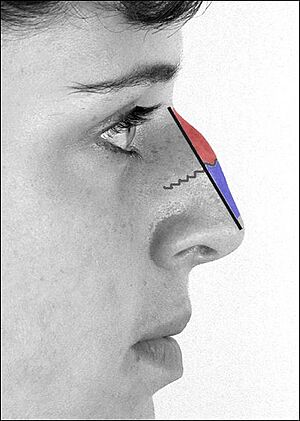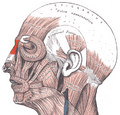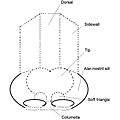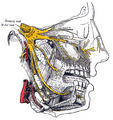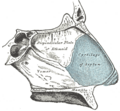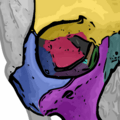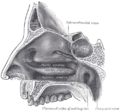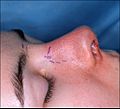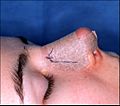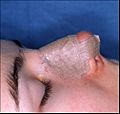Rhinoplasty facts for kids
Rhinoplasty, often called a nose job, is a type of plastic surgery that changes the shape of the nose. The word "rhinoplasty" comes from Greek words meaning "nose" and "to shape."
People have rhinoplasty for two main reasons:
- Reconstructive surgery: This helps fix the nose after an injury, or to correct problems someone was born with. It can also help with breathing problems, like a deviated septum.
- Cosmetic surgery: This is done to change how the nose looks. For example, someone might want to remove a bump, make their nostrils narrower, or change the angle between their nose and mouth.
Contents
What is a Nose Job?
A nose job is a surgical procedure that can change the size, shape, and angle of your nose. It can make your nose bigger or smaller, change the shape of the tip or bridge, or narrow the nostrils.
Why Do People Get a Nose Job?
People choose rhinoplasty for many reasons. Some want to improve their breathing if they have a problem like a deviated septum. This means the wall inside the nose that separates the nostrils is crooked, making it hard to breathe.
Others want to change the way their nose looks. They might feel their nose is too big, too small, or has a shape they don't like. Sometimes, a nose job is needed to fix the nose after an accident or injury.
How Does a Nose Job Work?
During a nose job, a surgeon works on the bone and cartilage that give the nose its shape. They can remove some bone or cartilage, or add tissue to change the nose's appearance. The skin over the nose is then reshaped over the new structure.
There are two main ways surgeons perform rhinoplasty:
- Open Rhinoplasty: The surgeon makes a small cut on the skin between the nostrils. This allows them to lift the skin and see the bones and cartilage clearly.
- Closed Rhinoplasty: The surgeon makes cuts inside the nostrils. This means there are no visible cuts on the outside of the nose.
After the surgery, a splint or cast is often placed on the nose to help it keep its new shape while it heals. Swelling and bruising are common for a few weeks after the procedure.
Nose Anatomy: What's Inside Your Nose?
To understand rhinoplasty, it helps to know a little about the nose's parts. Your nose is more than just the part you see on your face!
Bones and Cartilage
The upper part of your nose is made of bone. The lower part, including the tip and nostrils, is made of cartilage. Cartilage is a strong, flexible tissue. These bones and cartilages give your nose its unique shape.
Breathing Passages
Inside your nose are passages that help you breathe. Air enters through your nostrils and goes into your nasal cavities. These cavities are lined with a special tissue called squamous epithelium. They also have structures called turbinates, which help warm and moisten the air you breathe.
Muscles and Nerves
Small muscles, like the procerus muscle, help with facial expressions around your nose. Nerves, such as the trigeminal nerve, give your nose sensation, allowing you to feel touch or temperature.
Healing After a Nose Job
After a nose job, it's important to follow the surgeon's instructions carefully.
- You will likely have a splint or cast on your nose for about a week. This helps protect the new shape.
- There will be some swelling and bruising, especially around your eyes, which might look like "panda eyes." This is normal and will fade over time.
- It can take several months for all the swelling to go down and for the final shape of your nose to appear.
Images for kids
See also
 In Spanish: Rinoplastia para niños
In Spanish: Rinoplastia para niños


